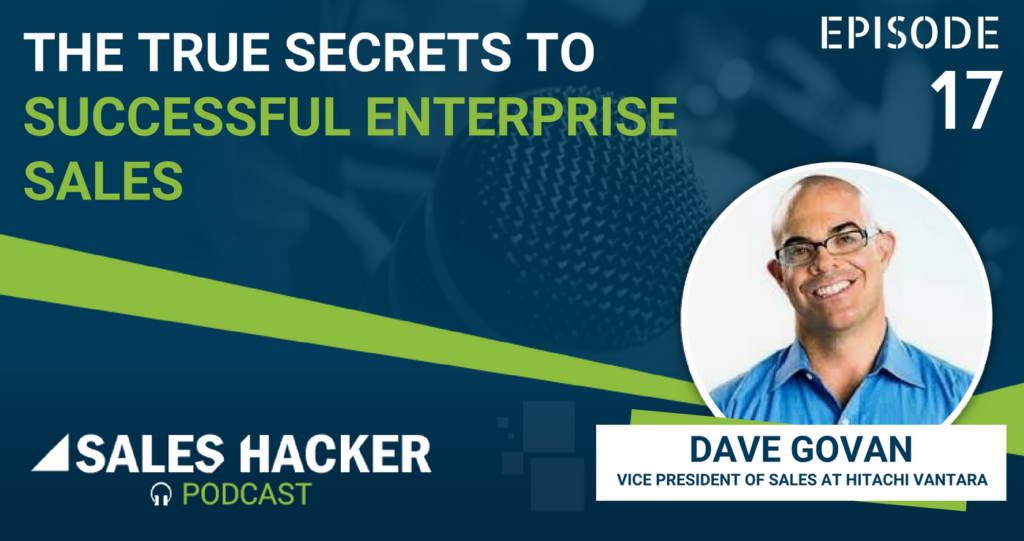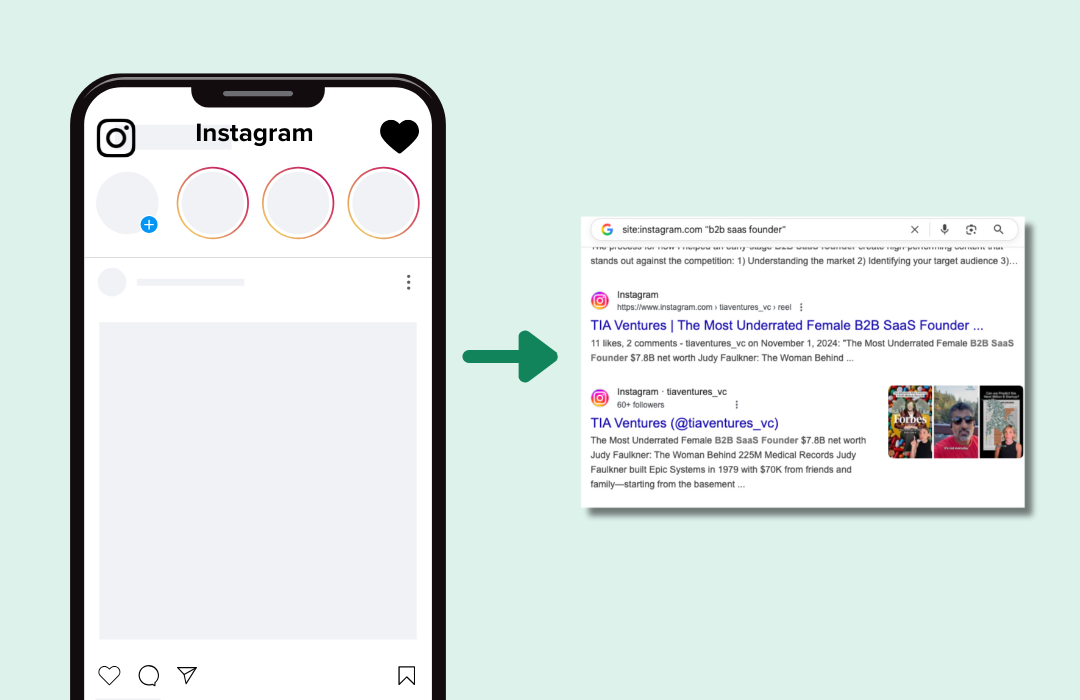This week on the Sales Hacker podcast, we feature longtime CRO, Dave Govan to chat about complex negotiations and sales cycles in enterprise sales. He’s currently VP of Sales at Hitachi Vantara and a Founding Member of the New York Revenue Collective.
If you missed episode 16, give it a listen here: PODCAST 16: From Idea to Scale — The Inside Story of Building Gong.io
What You’ll Learn
- How to move from simple to complex sales cycles and what their differences are
- Understanding how buyer group preferences impact selling decisions and strategies
- Developing a point of view on the power line and how to move above it
- The meaning of the phrase “The only plan that matters is power’s plan”
- Navigating complex bureaucracies and tools to help you overcome deal inertia
- How to act and think like a true sales executive
Subscribe to the Sales Hacker Podcast
Show Agenda and Timestamps
- Show Introduction [0:09]
- About Dave Govan: Baseball Card Stats [0:57]
- Transitioning from individual contributor to manager [5:26]
- Most founders ignore market maps [13:38]
- Not all pain points are worth solving [18:10]
- Pain point framework [24:24]
- Strategic functions to go to market with [30:24]
- Complex negotiations and sales cycles [33:44]
- Sam’s Corner [40:18]
Sales Hacker Podcast—Sponsored by Outreach
Sam Jacobs: Hi folks. Welcome to the Sales Hacker podcast. We’re excited about our new sponsor. This episode is being brought to you by Outreach, the leading sales engagement platform which triples the productivity of sales teams.
Thousands of customers, including Cloudera, Glassdoor, Pandora, and Zillow rely on Outreach to deliver higher revenue per sales rep.
Without further ado, let’s get on with the show!
About Dave Govan: Baseball Card Stats
Sam Jacobs: I’m delighted to have on today’s show a good friend of mine. He’s someone I consider a mentor — a founding member of the New York Revenue Collective. A great guy and one of the most respected sales leaders in the New York metropolitan area. We’ve got Dave Govan. He’s a VP of sales currently for Pentaho Solutions, which is part of Hitachi Vantara.
Welcome, Dave, to the show.
Dave Govan: Thank you, Sam. It’s great to be here!
Transitioning from Individual Contributor to Manager
Sam Jacobs: What are the things you think you did particularly well that enabled you to make that transition from individual contributor to manager?
Dave Govan: I transitioned over to Oracle and did very well there. It was in my second year I was actually Global Account Manager of the year. There, I received an award from Oracle’s Executive Committee. My desire to grow in my career was pretty strong, and I really like serving others.
Any effective leader knows that at the end of the day it’s really all about your team and your customers. So coming off of a really great year, I received a double promotion to a regional manager level. It’s like a first level VP.
I was pretty young at the time and didn’t really have much sales management coaching or leadership training. But I just jumped into the role and ran at it.
Most Founders Ignore Market Maps
Sam Jacobs: What are some of the biggest lessons you’ve learned from your time at startups and high growth companies?
Dave Govan: It seems like when startups get going, they’re heavily focused on the core product or products, right? And that’s natural because obviously they come up with an idea to innovate in business and someone has a brilliant idea and then it gets funding.
That person is often a product-oriented person or an engineer or something like that. But there’s this whole other commercial aspect that is heavily dependent on a go-to-market strategy that’s executed through market maps.
And the market map starts with the voice of the customer and then goes through about five or six aspects all the way through to marketing and sales execution.
Without that, it’s very easy to stray off course. That doesn’t mean you don’t create a new course sometimes.
If you discover something along the way, that’s just more exciting and bigger, go for it.
Not All Pain Points Are Worth Solving
Sam Jacobs: It’s not just enough to solve somebody’s acute pain. You need to solve somebody’s acute pain that has power in the organization, right?
Dave Govan: Sure. It’s actually more straightforward than one might think. It takes a lot of just basic empathy and common sense. A little bit of planning but not a lot.
The first guiding principle is, “The only plan that matters is power’s plan.”
You can ask anyone in my organizations over the years and they’ll laugh and chuckle and tell you they’ve heard that a million times. But it’s really true. The only plan that really matters when you’re selling to a enterprise is power’s plan.
Pain point framework: Being smart about what you solve
Sam Jacobs: One of the non-obvious dimensions of this process is how you think about different types of pain. And, how there are certain types of pain that actually aren’t interesting enough for a solution to be implemented. Walk us through that framework.
Dave Govan: In technology, many of those features link to solving operational pain but if you move upstream, there could be cultural pain, financial pain or a strategic pain.
It’s easy to define those types of pain because it’s just business, right?
A strategic pain is, “Hey, I’m losing market share to my chief competitor because my organization moves slower.” If your solution helps them get to information faster and get better insight into the decisions they’re making to compete — maybe deliver a product faster or increase their pipeline in R&D — then you’re actually going to impact strategic pain.
Strategic Functions to Go to Market With
Sam Jacobs: What are some of the roles that you have that you go to market with?
Dave Govan: Let me answer that from a startup perspective because I think that would be more relevant. When I’m hired as a startup CRO, I need to establish a lead gen function or field marketing function. I firmly believe events are one of the most critical and effective ways to actually engage with the right audience.
If we’re able to get really hyper targeted when it comes to smaller events like dinners and boutique conferences, it goes a long way. Not that we’ll stop the sales development function by any means but it’s just another way to do it.
So usually, I think one AE to two SDRs or to three SDRs is a good range. I’ve stretched it to four and that has caused a lot of stress and I wouldn’t recommend that.
And again, it depends on the nature of your business and how much money you can invest. And then, sales operations, once you get going, when you’re starting to roll, then you need a good sales operations person. I think in the beginning you could outsource that.
Complex Negotiations and Sales Cycles — How AEs Fit In
Sam Jacobs: What percent of pipeline should come from AEs versus their SDRs or marketing? How do you think about pipeline contribution?
Dave Govan: The more we can get from from marketing or SDRs, the better off we’re going to be but that’s often just not the case. Realistically, what I’ve seen is anywhere from 25 to 33 percent coming from those functions and the balance of the burden being on the account execs.
There’s just no substitute for that type of account executive that can actually call on power, call on mid-level managers and find opportunities. They’re highly capable of getting introductions from partners or other colleagues or people that they’ve known before.
Bonus read: 7 Sales Triggers Guaranteed to Uncover New Sales Opportunities
Sam’s Corner
Sam Jacobs: Hey, folks. It’s Sam’s Corner. I meant it when I said Dave Govan is a big influence on me and a big mentor in a lot of the processes that we’ve designed here have been strongly influenced by Dave.
We talk a lot about pain but there’s different types of pain. An operational pain tends to sit within and below the power line. People may experience inefficiencies in their daily work flow. That pain is not always important enough for the CEO or a C-level executive at an organization to sign off on. You really need to figure out what is the pain that the power has that the solution can solve.
Think about moving above the power line and speaking to pain that resonates with the C-suite in the organization if you’re working on an enterprise sale.
Don’t Miss Episode 18
To check out the show notes, see upcoming guests, and play more episodes from our incredible lineup of sales leaders, visit gtmnow.com/podcast-subscribe
You can also find the Sales Hacking podcast on iTunes or Stitcher. If you enjoyed this episode please give us a share on LinkedIn or Twitter.
Finally, a special thanks again to this month’s sponsor, Outreach. If you want to get in touch with me, find my social handles in my bio below.
I’ll see you next time!







